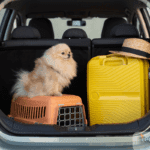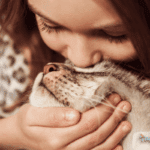Golden Retrievers are celebrated for their gentle temperament, striking golden coats, and unwavering loyalty. Often referred to as one of the most affectionate and versatile dog breeds, Golden Retrievers excel in numerous roles—from loving family pets to therapy companions and skilled working dogs.
With their friendly demeanor and eagerness to please, Golden Retrievers have earned their place as one of the most popular dog breeds worldwide. Their intelligence and trainability make them ideal for families, active individuals, and first-time dog owners seeking a loyal and devoted companion.
Whether it’s playing fetch in the park, swimming on a sunny day, or snuggling up with their favorite humans, the Golden Retriever brings joy, energy, and reliable companionship to every home.
Golden Retrievers are known for their intelligence and obedience. Learning “Essential Dog Training Commands” can further enhance their capabilities.
Quick Facts: Golden Retriever
Here’s a snapshot of the Golden Retriever traits to help you understand their unique qualities:
| Characteristic | Description | Rating |
|---|---|---|
| Size | Males: 23–24 in (58–61 cm), 65–75 lbs (29–34 kg); Females slightly smaller | ⭐⭐⭐⭐ |
| Average Lifespan | 10–12 years | ⭐⭐⭐ |
| Intelligence Ranking | Highly intelligent and eager to please | ⭐⭐⭐⭐⭐ |
| Exercise Requirements | High; need 1–2 hours of activity daily | ⭐⭐⭐⭐⭐ |
| Grooming Needs | Moderate; regular brushing and shedding control required | ⭐⭐⭐ |
| Training Adaptability | Very trainable with positive reinforcement | ⭐⭐⭐⭐⭐ |
| Compatibility with Children | Excellent; gentle and patient with kids | ⭐⭐⭐⭐⭐ |
| Energy Level | High; playful and active | ⭐⭐⭐⭐⭐ |
| Shedding Level | Moderate to high; seasonal shedding | ⭐⭐ |
| Apartment Living | Possible with sufficient exercise and mental stimulation | ⭐⭐⭐ |
| Health Issues | Prone to hip dysplasia, cancer, and allergies | ⭐⭐⭐ |
| Cost of Ownership | Moderate to high; includes food, grooming, and veterinary care | ⭐⭐⭐ |
| Vocal Tendency | Low to moderate; barks to alert | ⭐⭐ |
| Social Needs | High; thrives on companionship and attention | ⭐⭐⭐⭐⭐ |
- • Loving and Loyal: Golden Retrievers form strong emotional bonds with their families. Their affectionate nature makes them perfect companions, always eager to be by their owner’s side and offering unmatched loyalty.
- • Highly Intelligent and Trainable: Known for their sharp minds, Golden Retrievers are eager to learn and quick to master commands. They excel in obedience training, agility competitions, and therapy work, making them ideal for first-time owners.
- • Energetic and Playful: These dogs have boundless energy and a love for play. Daily activities like swimming, running, and interactive games like fetch are essential to keep them healthy and happy.
- • Family-Friendly: With their gentle temperament and patient demeanor, Golden Retrievers are wonderful with children and other pets. Their playful yet calm nature makes them perfect for families of all sizes.
- • Moderate Shedding but Manageable: While Golden Retrievers shed year-round—especially during seasonal changes—regular brushing and proper grooming routines can help control fur and keep their coat healthy.
- • Adaptable and Versatile: Golden Retrievers thrive in various roles and environments. Whether as a therapy dog, a working dog, or a loving family pet, their versatility is unmatched.

History and Origins of the Golden Retriever
The Golden Retriever, often described as the epitome of loyalty and versatility, has a storied history that highlights its intelligence, adaptability, and enduring charm. Developed in the Scottish Highlands during the late 19th century, this iconic breed was purposefully crafted to assist hunters with retrieving game across rugged terrains and icy waters. However, their journey didn’t stop there—the Golden Retriever quickly proved itself as much more than a working dog, winning hearts around the world with its affectionate nature and unmatched versatility.
Quick Facts About Golden Retriever Origins
| Aspect | Detail |
|---|---|
| Geographic Origin | Scottish Highlands, United Kingdom |
| Purpose | Retrieving waterfowl and upland game during hunting excursions |
| First Recognition | Recognized by The Kennel Club of England in 1913 |
| Introduction to the U.S. | Early 20th century; quickly became a family favorite |
| Notable Contributions | Therapy dogs, guide dogs, and companions worldwide |
| Breed Development | Crossbred from the Tweed Water Spaniel, Irish Setter, and Bloodhound |
Golden Retriever Breed Development in the Scottish Highlands
In the mid-19th century, Lord Dudley Marjoribanks, later known as Lord Tweedmouth, sought to develop the ultimate hunting companion. A visionary breeder, Lord Tweedmouth dreamed of a dog with the stamina to endure long hunting trips in Scotland’s misty Highlands, the strength to retrieve game from icy waters, and the gentleness to hold prey without damage—a trait known as a “soft mouth.”
In 1868, Lord Tweedmouth began crossing the now-extinct Tweed Water Spaniel with breeds like the Irish Setter and Bloodhound. Each breeding choice was deliberate, enhancing specific qualities:
- The Tweed Water Spaniel contributed its excellent swimming abilities and loyalty.
- The Irish Setter brought grace, elegance, and endurance.
- The Bloodhound added its keen sense of smell, improving tracking capabilities.
The result? A dog perfectly suited for retrieving waterfowl and upland game across Scotland’s expansive lakes and challenging landscapes. Golden Retrievers were not just functional—their gentle temperament and eagerness to please were evident early on, making them a joy both in the field and at home.
From Hunting Fields to Family Homes
While Golden Retrievers were initially bred for their prowess in hunting, their friendly demeanor and intelligence quickly endeared them to families beyond the hunting community. By the early 20th century, Golden Retrievers made their way to North America, where they captured the hearts of dog lovers and professionals alike.
A Breed of Many Talents
Golden Retrievers’ versatility allowed them to excel in various roles:
- Service and Therapy Dogs: Their patient and calm disposition makes them ideal for assisting individuals with disabilities and providing emotional support.
- Search-and-Rescue Heroes: With a strong sense of smell and boundless energy, Golden Retrievers excel at locating missing persons.
- Family Companions: Their affectionate personalities and playful energy make them perfect for families, especially those with children.
Recognition and Global Popularity
The Kennel Club of England officially recognized the Golden Retriever as a distinct breed in 1913, marking a pivotal moment in its history. The American Kennel Club (AKC) followed suit in 1925, and the breed quickly rose to fame for its intelligence, beauty, and friendly nature.
By the mid-20th century, Golden Retrievers had become beloved staples in dog shows, working roles, and households around the world. Their reputation for loyalty, versatility, and good-natured charm ensured their place as one of the most popular and recognizable dog breeds globally.
Why the Golden Retriever Stands Out
From the misty lakes of the Scottish Highlands to modern-day family homes, the Golden Retriever’s journey has been one of purpose and heart. Their ability to adapt—whether as hunting companions, therapy heroes, or beloved family pets—sets them apart as a breed that truly does it all. Few dogs embody intelligence, loyalty, and affection as effortlessly as the Golden Retriever.helpers makes them a breed like no other. Whether serving as a therapy dog, an outdoor companion, or a cherished family member, the Golden Retriever remains a timeless favorite.
Before welcoming a Golden Retriever into your home, consider these “10 Essential factors for bringing a new pet home”.

Personality Traits of the Golden Retriever
The Golden Retriever, renowned for its friendly, gentle, and affectionate nature, is one of the most beloved dog breeds in the world. These dogs are celebrated for their intelligence, unwavering loyalty, and boundless enthusiasm, making them ideal for families, active individuals, and first-time dog owners alike. Their adaptable personality ensures they excel as both working dogs and loving companions.
Table: Golden Retriever Personality Profile
| Trait | Description |
|---|---|
| Intelligence | Exceptionally intelligent and quick learners; excel in obedience and training. |
| Energy Level | High energy; require 1–2 hours of exercise daily to stay happy and healthy. |
| Social Interaction | Extremely affectionate; bonds deeply with family members and strangers alike. |
| Protectiveness | Naturally friendly; not overly protective but will alert their family. |
| Trainability | Highly trainable with positive reinforcement; eager to please. |
| Compatibility with Kids | Excellent; gentle and patient, making them ideal family dogs. |
| Compatibility with Pets | Very sociable; thrives in multi-pet households with proper socialization. |
Loyal and Affectionate Companions
Golden Retrievers are the embodiment of loyalty and affection. They form deep emotional bonds with their families and thrive in homes where they are treated as active members of the household. Known as “people dogs,” Goldens crave human companionship and flourish when included in daily activities, whether it’s outdoor adventures, playtime, or simply relaxing with their loved ones.
Real-Life Example: Golden owners often share touching stories of their dogs’ devotion, such as staying by a child’s side during illness or waiting patiently by the door for their favorite humans to return. Goldens truly live to love and be loved.
Energetic and Playful
Golden Retrievers maintain their playful energy well into adulthood, bringing constant joy and fun to their families. Their high energy levels require daily exercise to keep them physically and mentally satisfied. Without sufficient activity, boredom can lead to unwanted behaviors like chewing or digging.
Exceptionally Intelligent and Trainable
Golden Retrievers are ranked among the smartest dog breeds, excelling in both obedience and problem-solving. Their eagerness to learn, combined with a natural desire to please, makes them ideal candidates for advanced training, therapy work, and service roles.
Pro Tip: Short, engaging training sessions using positive reinforcement—such as treats, verbal praise, or play—are highly effective with Goldens. Consistency and patience will help them master commands, tricks, and advanced tasks with ease.
Real-Life Example: Golden Retrievers frequently star in obedience competitions, therapy programs, and search-and-rescue missions. Owners report their Goldens performing tasks like retrieving items, opening doors, or assisting individuals with disabilities, showcasing their intelligence and versatility.
Friendly and Social
Golden Retrievers are naturally outgoing and welcoming, thriving in social settings. They are rarely reserved, making them excellent family companions but less suited as guard dogs. Goldens are equally affectionate with strangers and family members, bringing warmth to any environment they enter.
Key Insight: Proper early socialization ensures your Golden grows up to be confident and well-mannered, especially around other pets, visitors, and unfamiliar situations.
Real-Life Example: Many families with multiple pets describe their Golden as the “peacekeeper,” effortlessly bonding with cats, other dogs, and children. Their gentle and patient nature allows them to adapt to various household dynamics.
Calm Yet Emotionally Attuned
Golden Retrievers are not only playful but also remarkably emotionally sensitive. Known for their ability to pick up on human emotions, Goldens are natural therapy and emotional support dogs, offering quiet comfort during times of stress or sadness.
Fun Fact: Goldens have an innate “smile” and expressive eyes that seem to communicate understanding and empathy—a trait that endears them to families, individuals, and professionals alike.
Real-Life Example: Golden owners often share heartwarming stories of their dogs instinctively offering support during tough times, such as resting their heads on a loved one’s lap after a stressful day or staying close during moments of illness or grief.
Why Choose a Golden Retriever?
If you want a loving, intelligent, and endlessly loyal companion, the Golden Retriever is an unbeatable choice. Their adaptable nature makes them perfect for families, active owners, and those seeking a gentle, social, and trainable dog. With proper care, exercise, and attention, a Golden Retriever will reward you with years of joy, companionship, and unconditional love.
Golden Retrievers are celebrated for their intelligence and eagerness to please. Mastering “Essential Dog Training Commands” can help bring out their full potential.
Golden Retrievers thrive on companionship but can develop separation anxiety. Learn more about “Understanding and Managing separation anxiety in dogs”.

Physical Characteristics of the Golden Retriever
The Golden Retriever, with its iconic golden coat, athletic build, and kind expression, is a breed that perfectly balances elegance, strength, and functionality. Bred to retrieve game across rough terrain and cold waters, every aspect of their physical form reflects their versatility, stamina, and approachable nature. These features make Golden Retrievers not only strikingly beautiful but also capable of excelling in both work and play.
Size and Build
| Trait | Description |
|---|---|
| Average Height | Males: 23–24 in (58–61 cm); females: 21.5–22.5 in (55–57 cm) |
| Average Weight | Males: 65–75 lbs (29–34 kg); females: 55–65 lbs (25–29 kg) |
| Body Type | Strong, muscular, well-balanced, and athletic |
Golden Retrievers boast a harmonious build that is both robust and graceful. Their deep chest, straight back, and strong limbs give them the endurance and agility needed for physically demanding tasks like swimming, hiking, and fieldwork.
Notable Features
Golden Retrievers have a soft yet powerful expression, instantly recognizable by their kind eyes and radiant golden coats. Their physical features include:
- Eyes: Medium-sized, dark brown, and set well apart, reflecting warmth, intelligence, and curiosity.
- Ears: Soft, pendant-shaped, and medium-sized, hanging close to the cheeks, adding to their approachable demeanor.
- Muzzle: Broad and straight, with a strong jaw and the signature “soft mouth,” perfect for carrying items without damage.
- Tail: Long and feathery, carried level with the back, often wagging enthusiastically to match their cheerful personality.
Golden Retrievers move with a smooth, flowing gait, showcasing their strength, balance, and graceful energy—a true reflection of their origins as athletic working dogs.
Coat and Colors
| Trait | Description |
|---|---|
| Coat Type | Double coat: dense, water-resistant outer layer with a soft insulating undercoat |
| Coat Texture | Wavy or straight; feathering on the legs, chest, and tail adds elegance |
| Coloring | Various shades of gold, ranging from light cream to deep, rich golden hues |
The Golden Retriever’s double coat is designed for both function and beauty. The soft undercoat provides insulation in cold weather, while the dense, water-resistant outer layer protects them during outdoor adventures, particularly swimming and fieldwork.
Their coat is one of their defining features, with shades ranging from light cream to dark golden hues. Seasonal shedding occurs heavily in spring and fall, requiring regular grooming to keep their coat healthy and manageable.
Facial Features and Posture
| Feature | Description |
|---|---|
| Eyes | Medium-sized, dark brown, conveying warmth, kindness, and intelligence |
| Ears | Hanging close to the head, soft and medium-sized |
| Tail | Long, feathery, carried level with the back when relaxed or wagging actively |
Golden Retrievers have an alert yet gentle posture that complements their kind demeanor. Whether standing tall or bounding playfully, their balance, poise, and fluid movement reflect their working-dog roots.
Key Physical Traits of the Golden Retriever
- Athletic Build: Golden Retrievers are strong, muscular, and agile, making them excellent companions for outdoor activities like swimming, hiking, and running.
- Distinctive Double Coat: Their water-resistant coat is ideal for outdoor adventures but requires consistent grooming to maintain its health and shine.
- Golden Coloring: Their lush golden shades are iconic, giving the breed its name and timeless appeal.
- Expressive Features: The combination of kind eyes, soft ears, and a wagging tail reflects their affectionate and joyful personality.
Why Understanding These Characteristics Matters
Understanding the physical traits of Golden Retrievers helps owners meet their grooming, exercise, and care needs. Their athletic build and double coat are not just aesthetic—they reflect the breed’s origins as hardworking retrievers in harsh conditions.
Why the Golden Retriever Stands Out
The Golden Retriever’s physical characteristics are a harmonious blend of strength, elegance, and practicality. Their radiant coat, balanced build, and expressive features make them one of the most recognizable breeds, while their stamina and athleticism ensure they can thrive in various roles—from hiking companions to therapy dogs. For owners seeking a dog that is as functional as it is beautiful, the Golden Retriever delivers on every front.
Did you know that some Golden Retrievers love sticking out their tongues? Find out other reasons why in this vet-reviewed guide.

Health and Lifespan of the Golden Retriever
Golden Retrievers are cherished for their gentle demeanor, boundless energy, and unwavering loyalty, but like all breeds, they are prone to specific health conditions that require careful attention. With an average lifespan of 10 to 12 years, Golden Retrievers can enjoy long, healthy lives with proper care, regular veterinary checkups, and a balanced lifestyle. Proactive health management ensures they remain the happy, playful companions they are known to be.
Average Lifespan of Golden Retriever
The typical lifespan of a Golden Retriever is 10 to 12 years, which is standard for medium-to-large breeds. Genetics, diet, exercise, and preventive care all play a significant role in their longevity. While Golden Retrievers are resilient, their predisposition to certain health issues highlights the importance of early intervention and preventive measures.
Common Health Issues in Golden Retriever
Golden Retrievers are predisposed to several hereditary and lifestyle-related health conditions. Awareness of these concerns allows owners to take proactive steps to manage or prevent them.
| Condition | Description |
|---|---|
| Hip Dysplasia | A genetic condition causing improper hip joint development, leading to pain and arthritis. |
| Elbow Dysplasia | Abnormal development of the elbow joint, resulting in discomfort and reduced mobility. |
| Cancer | Golden Retrievers are prone to cancers such as lymphoma and hemangiosarcoma. |
| Heart Issues | Conditions like subvalvular aortic stenosis (SAS) affect heart function and energy levels. |
| Obesity | Poor diet and insufficient exercise can lead to excessive weight gain and related complications. |
| Hypothyroidism | A hormonal disorder causing lethargy, weight gain, and coat thinning. |
| Ear Infections | Goldens’ floppy ears can trap moisture, increasing the risk of bacterial and yeast infections. |
Preventive Care and Regular Vet Checkups
Preventive care is the cornerstone of keeping Golden Retrievers healthy and active. Regular veterinary visits, proper grooming, and maintaining an active lifestyle can help address potential health concerns before they become serious.
| Health Aspect | Recommended Action | Frequency |
|---|---|---|
| Hip and Joint Health | Monitor for stiffness or limping; use joint supplements as needed. | Annually or as needed |
| Weight Management | Provide a balanced diet and portion-controlled meals; encourage exercise. | Monthly monitoring |
| Cancer Screenings | Regular checkups to detect lumps or abnormalities early. | As recommended by your vet |
| Ear Hygiene | Clean ears regularly to reduce the risk of infection. | Weekly |
| Dental Care | Brush teeth and offer dental chews to maintain oral health. | Weekly; annual cleaning |
| Heart Health | Screen for heart conditions like SAS with veterinary exams. | Annually |
| Thyroid Screening | Blood tests to detect hypothyroidism early. | Annually |
Signs of Illness to Watch For in Golden Retriever
Being aware of early warning signs allows for timely intervention, which can greatly improve outcomes. Monitor your Golden Retriever for the following symptoms:
- Mobility Issues: Limping, stiffness, or difficulty rising may signal hip or elbow dysplasia.
- Unexplained Weight Gain or Loss: Could indicate hypothyroidism, metabolic disorders, or cancer.
- Lethargy or Fatigue: A reduction in energy levels may point to heart disease, obesity, or underlying illness.
- Excessive Scratching or Ear Odor: Symptoms of ear infections common in Goldens due to trapped moisture.
- Lumps or Swellings: Seek immediate veterinary evaluation for any unusual bumps or growths.
- Digestive Issues: Vomiting, bloating, or excessive gas can indicate gastrointestinal problems.
Some owners explore options like “CBD oil for dogs” to manage joint discomfort.
Golden Retrievers may face certain health challenges. Stay informed about the “11 Warning signs your dog needs a vet visit”.
Ensuring a Healthy Life for Your Golden Retriever
Proactive care is key to ensuring that Golden Retrievers live long, happy lives. Their energetic nature and love for companionship require regular physical activity, mental stimulation, and attentive healthcare.
Key Areas of Care:
- Balanced Nutrition: Feed a high-quality diet tailored to your Golden’s age, size, and activity level. Avoid overfeeding to prevent obesity.
- Regular Exercise: Aim for 1–2 hours of activity daily, including walks, swimming, or playtime.
- Grooming and Hygiene: Brush your Golden’s coat 2–3 times a week and clean their ears regularly to prevent infections.
- Routine Veterinary Screenings: Schedule annual exams, cancer screenings, and joint health assessments to catch issues early.
Why Health Awareness Matters
Golden Retrievers are loyal, loving companions, and understanding their health needs is essential to providing them with the best quality of life. By prioritizing preventive care, balanced nutrition, and regular exercise, you can ensure your Golden remains by your side for many joyful years.
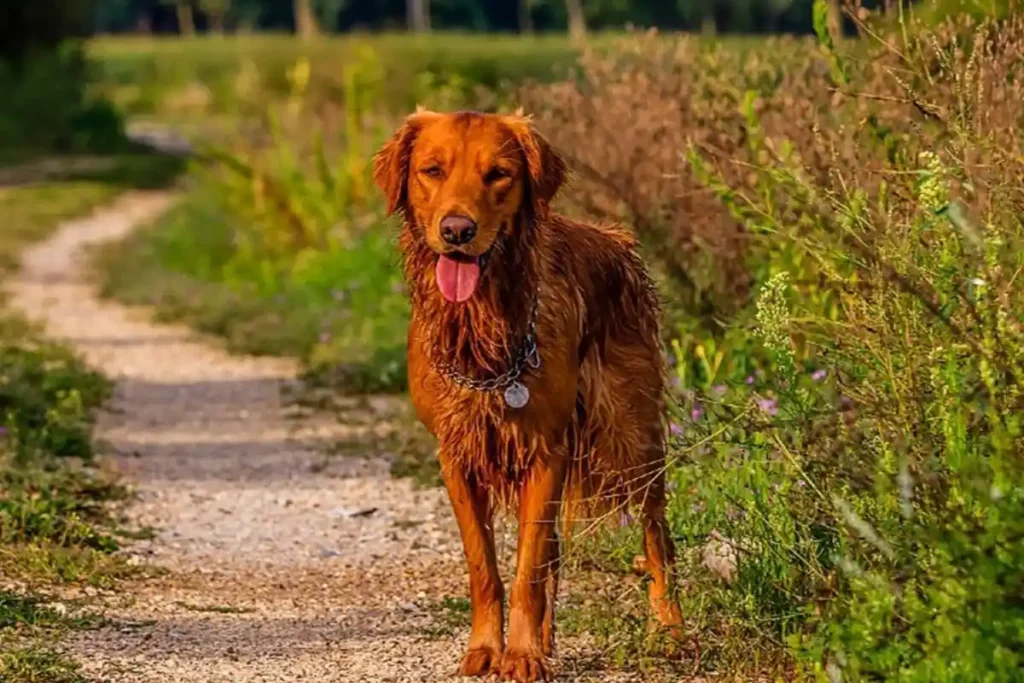
Caring for an Golden Retriever: Grooming, Diet and Enrichment Tips
Golden Retrievers, with their playful energy and affectionate nature, thrive when their physical, mental, and emotional needs are met. By focusing on proper grooming, balanced nutrition, and consistent mental stimulation, owners can ensure their Golden Retrievers lead healthy, happy, and fulfilling lives. Understanding and catering to their care requirements is key to raising a well-rounded companion.
Table: Care Requirements for Golden Retriever
| Care Aspect | Requirement Level | Frequency | Details | Importance Rating |
|---|---|---|---|---|
| Grooming | High | 2–3 times weekly | Brushing, bathing, and ear cleaning to maintain coat health. | ⭐⭐⭐⭐⭐ |
| Feeding | High | Daily | High-quality protein diet with controlled portions. | ⭐⭐⭐⭐⭐ |
| Exercise | Very High | Daily | 1–2 hours of physical activity like walks, play, and swimming. | ⭐⭐⭐⭐⭐ |
| Mental Stimulation | Very High | Continuous | Training, puzzle toys, and interactive play. | ⭐⭐⭐⭐⭐ |
| Environment | High | Continuous | Comfortable resting spaces and secure outdoor areas. | ⭐⭐⭐⭐ |
Grooming: Maintaining That Signature Golden Shine
Golden Retrievers have a beautiful double coat that requires regular care to keep it healthy and manage shedding. Without proper grooming, their coat can mat, collect debris, or cause skin irritation.
Key Grooming Practices:
- Brushing: Brush their coat 2–3 times a week with a slicker brush to reduce shedding, prevent matting, and distribute natural oils.
- Bathing: Bathe monthly with a gentle, dog-safe shampoo to keep their coat clean and shiny without stripping natural oils. Read more on “How to bathe your dog stress-free“
- Ear Care: Clean their ears weekly with a vet-approved solution to prevent moisture buildup and infections.
- Nail Trimming: Trim nails every 2–3 weeks to avoid overgrowth, which can cause discomfort or affect gait.
- Dental Hygiene: Brush their teeth 2–3 times a week and offer dental chews to maintain oral health and reduce plaque buildup.
Diet and Nutrition: Fueling Their Energy and Vitality
Nutrition: Fueling Energy, Health, and Longevity
Golden Retrievers have high energy needs, making nutritionally balanced meals essential for maintaining their vitality, coat health, and weight.
Key Nutritional Needs:
- High-Quality Protein: Look for premium dog food with real meat or fish as the first ingredient to support lean muscle mass.
- Healthy Fats: Include Omega-3 and Omega-6 fatty acids (from salmon oil, flaxseed, or fish) for skin health and a shiny coat.
- Controlled Portions: Overfeeding can quickly lead to obesity, putting strain on their joints and increasing health risks.
Feeding Schedule:
- Adults: 2 balanced meals per day with portion sizes tailored to weight, age, and activity level.
- Puppies: 3–4 smaller meals a day to support rapid growth.
Read more on “10 Things to Consider Before Bringing a New Pet Home”
Hydration
Always provide fresh water, especially after exercise or during warm weather. Active dogs like Golden Retriever require consistent hydration to stay healthy.
Exercise: Meeting Their Energy Needs
Golden Retrievers are active, playful dogs that require daily physical activity to stay fit and avoid boredom. Proper exercise also helps prevent obesity, supports joint health, and strengthens the bond between dog and owner.
Physical Activity Recommendations:
- Daily Exercise: Provide 1–2 hours of physical activity such as long walks, running, swimming, or games of fetch.
- Low-Impact Activities: Swimming is especially beneficial for Goldens prone to joint issues like hip dysplasia, as it’s gentle on their bodies.
- Agility and Sports: Enroll in agility training or obedience classes to challenge their athleticism and mental sharpness.
Mental Stimulation: Golden Retrievers thrive on mental challenges. Keep their active minds engaged with:
- Puzzle Toys and Treat Dispensers: Encourage problem-solving while rewarding curiosity.
- Training Sessions: Use positive reinforcement to teach commands, tricks, and games.
- Interactive Play: Play hide-and-seek or introduce scent-tracking games to mimic their retrieving instincts.
Interactive toys and training sessions are some of the “9 Simple ways to make your dogs happy”.
Creating a Comfortable Environment
Golden Retrievers are happiest when they are included in family life. Create a home environment that meets their needs for activity, rest, and comfort:
- Indoors: Provide a cozy resting area with soft bedding for relaxation after playtime. Use crates as safe, calm zones.
- Outdoors: Ensure a secure backyard for safe playtime, and offer enrichment like obstacle courses or designated digging areas.
- Temperature Awareness:
- Hot Weather: Ensure shade, hydration, and avoid outdoor activity during peak heat.
- Cold Weather: While Goldens tolerate cold weather well, provide a warm resting area in freezing conditions.
Why Proper Care Matters
Golden Retrievers are loyal, playful, and intelligent companions who give their families unconditional love. By focusing on their grooming, nutrition, exercise, and mental well-being, you’ll ensure your Golden thrives in every aspect of life.
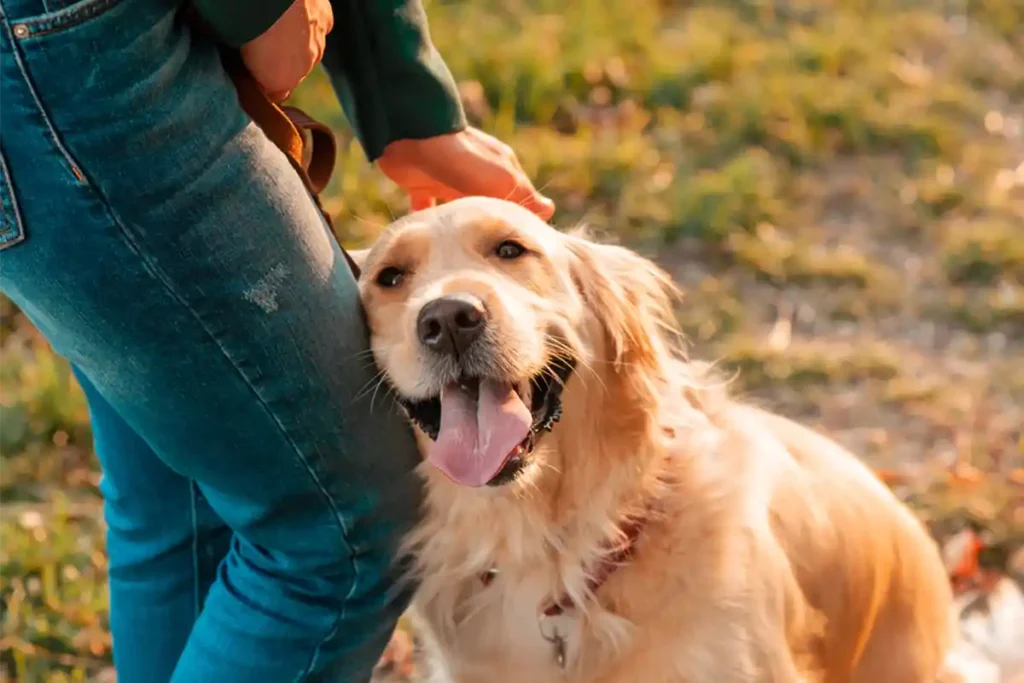
Owning an Golden Retriever: Budgeting and Financial Insights
Bringing a Golden Retriever into your home is a joyful and rewarding decision, but it’s essential to understand the financial commitment that comes with owning this beloved breed. From initial setup costs to ongoing care expenses, planning ahead ensures your Golden Retriever receives the care and attention they deserve throughout their life.
Table: Cost Breakdown Analysis for Golden Retrievers
| Expense Category | Initial Cost (USD) | Annual Cost (USD) | Value Rating |
|---|---|---|---|
| Adoption or Breeder Fees | $300–$3,000 | N/A | ⭐⭐⭐⭐⭐ |
| Food and Treats | N/A | $600–$1,200 | ⭐⭐⭐⭐⭐ |
| Grooming | $50–$100 | $300–$700 | ⭐⭐⭐⭐ |
| Veterinary Care | $200–$600 | $500–$1,500 | ⭐⭐⭐⭐⭐ |
| Pet Insurance | N/A | $300–$900 | ⭐⭐⭐⭐ |
| Toys and Enrichment | $50–$100 | $100–$300 | ⭐⭐⭐⭐ |
| Training Classes | $100–$500 | Optional | ⭐⭐⭐⭐⭐ |
| Emergency Care | $200–$5,000+ (varies) | N/A | ⭐⭐⭐⭐ |
Initial Costs: Preparing for Your Golden Retriever
Adoption vs. Breeder Fees
- Adoption Fees ($300–$600): Opting for a rescue or shelter is a cost-effective choice, often covering vaccinations, microchipping, and spaying/neutering.
- Breeder Fees ($1,500–$3,000): Purchasing from a responsible breeder ensures health-tested puppies with lineage guarantees, but this comes at a premium.
Essential Supplies for Day One
Prepare your home with the following essentials to ensure a smooth transition for your Golden Retriever:
| Item | Cost Range (USD) |
|---|---|
| Dog Crate | $50–$150 |
| Food and Water Bowls | $20–$50 |
| Leash and Collar | $30–$60 |
| Bed | $40–$100 |
| Toys | $20–$50 |
| Grooming Supplies | $50–$100 |
| Training Tools | $20–$40 |
Estimated Setup Cost: $200–$500
🐾 Tailwaggors Tip:
Invest in durable supplies like chew-proof leashes, sturdy crates, and long-lasting toys. These may cost more upfront but save money over time.
Ongoing Annual Costs
Food and Treats
Golden Retrievers require a high-quality, protein-rich diet to maintain their energy and overall health. On average, expect to spend:
| Food Type | Annual Cost Range (USD) |
|---|---|
| Dry Food | $400–$800 |
| Wet Food (Optional) | $200–$400 |
| Specialty/High-Protein Diets | $800–$1,200 |
🐾 Tailwaggors Tip:
Mix dry kibble with wet food for added hydration and dental health benefits. Consult your vet to determine appropriate portion sizes based on age, weight, and activity level.
Veterinary Care
Preventive veterinary care ensures your Golden Retriever remains healthy and avoids costly emergencies:
| Category | Annual Cost Range (USD) |
|---|---|
| Wellness Exams | $150–$300 |
| Vaccinations | $50–$100 |
| Flea, Tick, and Worm Prevention | $100–$200 |
| Dental Cleaning | $300–$600 (every 1–2 years) |
🩺 Veterinary Insight:
“Golden Retrievers are prone to issues like hip dysplasia, allergies, and cancer. Routine checkups, vaccinations, and dental cleanings are critical to catching health problems early and minimizing expenses later,” advises Dr. Esther Knoetze, BSc, BVSc.
Grooming
Golden Retrievers’ thick, double coats require regular upkeep to manage shedding and prevent matting:
| Type | Annual Cost Range (USD) |
|---|---|
| Professional Grooming | $300–$700 |
| At-Home Grooming Supplies | $50–$100 |
🐾 Tailwaggors Tip:
Brush your Golden Retriever 2–3 times a week using a slicker brush to manage shedding and reduce the frequency of professional grooming visits.
Training and Enrichment
Proper training and enrichment activities are essential for a well-rounded German Shepherd.
| Expense | Annual Cost Range (USD) |
|---|---|
| Training Classes | $100–$500 (initially) |
| Toys and Enrichment | $100–$300 |
Total Annual Training and Enrichment Cost: $200–$800
Hidden and Emergency Costs
- Emergency Vet Visits: $200–$5,000+ for surgeries, diagnostics, or critical care.
- Pet Boarding or Sitting: $25–$50 per day during travel.
- Prescription Diets: $500–$1,200 annually for conditions like allergies or obesity management.
🐾 Tailwaggors Tip:
Consider pet insurance to cover unexpected medical expenses, including surgeries and emergency care. Plans typically cost $300–$900 annually but provide peace of mind in emergencies.
Unexpected costs can arise. Prepare with this “Comprehensive Emergency guide for dog owners”.
Cost-Saving Strategies for Golden Retriever Owners
- Buy in Bulk: Save on food and supplies by purchasing larger quantities during sales.
- Preventive Healthcare: Regular vet visits help catch minor health issues before they become costly problems.
- DIY Grooming: Learn to brush, trim nails, and clean ears at home to minimize professional grooming costs.
- Invest in Quality Supplies: Durable toys, beds, and collars last longer and reduce replacement expenses.
Is Owning a Golden Retriever Worth the Investment?
Golden Retrievers are loving, loyal companions that bring endless joy to families. While they require financial planning, the investment is well worth the happiness and companionship they provide. By budgeting for their needs—from grooming to veterinary care—you’ll ensure your Golden Retriever lives a healthy, active, and fulfilling life.
Understanding “10 things to consider before bringing a new pet home” can help prepare for the costs of owning a Golden Retriever.
🐾 Tailwaggors Tip:
Owning a Golden Retriever isn’t just a cost—it’s an investment in a loyal, joyful family member. Plan ahead, embrace the journey, and your Golden will reward you with unconditional love and companionship.
🩺 Veterinary Insight:
“Golden Retrievers are among the most loving and adaptable breeds, but their care requires a financial commitment. Pet owners who budget for food, grooming, and preventive care ensure their Golden Retrievers lead happy and healthy lives,” says Dr. Esther Knoetze, BSc, BVSc.
Disclaimer:
The cost estimates provided in the “Owning an Alaskan Malamute: Budgeting and Financial Insights” section are general approximations based on current market trends and commonly reported expenses in the United States. Actual costs may vary depending on factors such as location, individual pet needs, specific health conditions, and lifestyle choices.
These estimates are intended for informational purposes only and should not replace personal research or consultations with veterinary or pet care professionals. We recommend setting aside additional funds for unexpected expenses, including emergency veterinary care and specialized dietary or training needs, to ensure your Alaskan Malamute receives the best possible care.
Always consult with a veterinarian or trusted breeder for detailed guidance tailored to your specific situation. Tailwaggors is not responsible for discrepancies or unforeseen costs that may arise.
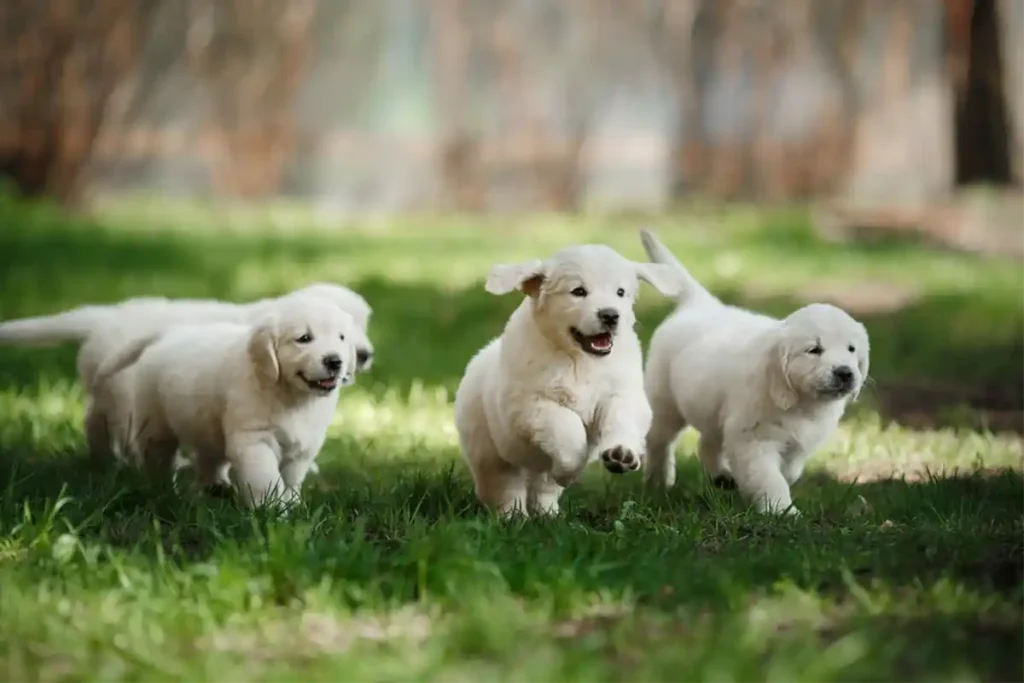
Breed Comparison: Golden Retriever vs. Other Popular Breeds
Choosing the right breed involves considering factors like size, temperament, energy levels, and grooming needs. Golden Retrievers, renowned for their friendly personalities, intelligence, and versatility, are often compared to Labrador Retrievers, Bernese Mountain Dogs, and Standard Poodles. Let’s explore how the Golden Retriever stacks up against these popular breeds to help you decide which is the best fit for your lifestyle.
Table: How Does the Golden Retriever Compare?
| Aspect | Golden Retriever | Labrador Retriever | Bernese Mountain Dog | Standard Poodle |
|---|---|---|---|---|
| Size | Large (55–75 lbs / 25–34 kg) | Large (55–80 lbs / 25–36 kg) | Extra Large (70–115 lbs / 31–52 kg) | Large (45–70 lbs / 20–32 kg) |
| Coat | Dense, water-resistant double coat | Short, water-resistant coat | Thick, long double coat | Dense, curly, hypoallergenic coat |
| Personality | Friendly, affectionate, outgoing | Friendly, playful, loyal | Gentle, calm, affectionate | Intelligent, active, elegant |
| Grooming Needs | Moderate (regular brushing) | Low (occasional brushing) | High (frequent brushing) | High (regular clipping and brushing) |
| Energy Level | High; thrives on activity and play | High; adaptable to exercise needs | Moderate; prefers structured exercise | High; needs mental and physical activity |
| Trainability | Highly trainable, eager to please | Highly trainable, eager to please | Trainable but independent at times | Very trainable, thrives on challenges |
| Compatibility with Pets | Excellent; friendly with other pets | Excellent; social and adaptable | Good; needs early socialization | Excellent; highly sociable |
Golden Retriever vs. Labrador Retriever
Golden Retrievers and Labrador Retrievers are both adored for their loving personalities and versatility, but they do have key differences:
- Coat and Grooming: Goldens’ longer, double coat requires more frequent brushing to control shedding and prevent matting. Labs, with their shorter coats, are lower maintenance.
- Personality: Golden Retrievers are known for their gentle, patient demeanor, whereas Labs tend to be more exuberant and playful, making them ideal for highly active families.
- Energy Levels: Both breeds are energetic, but Labs can be slightly more boisterous in their early years, while Goldens offer a balanced mix of energy and calmness.
🐾 Tailwaggors Tip: If you’re looking for a slightly calmer companion that thrives on affection, the Golden Retriever is ideal. For highly active families who want a playful, easy-to-groom dog, the Labrador Retriever may be the better choice.
Golden Retriever vs. Bernese Mountain Dog
The Bernese Mountain Dog and Golden Retriever share gentle temperaments but differ Golden Retrievers and Bernese Mountain Dogs are both gentle and affectionate, but their size, grooming needs, and energy levels differ significantly:
- Size: Bernese Mountain Dogs are larger and heavier, often weighing up to 115 lbs (52 kg), which requires extra space and careful weight management.
- Coat: Berners’ thick, long coats demand frequent brushing to prevent matting and tangles, while Golden Retrievers have easier-to-maintain fur with regular grooming.
- Energy Levels: Bernese Mountain Dogs have a moderate energy level and prefer structured activities like hiking. Golden Retrievers are more playful and require more frequent physical and mental engagement.
🐾 Tailwaggors Tip: If you want a large, calm companion with a protective nature, the Bernese Mountain Dog fits the bill. For families looking for an energetic, outgoing companion, the Golden Retriever is the winner.
Golden Retriever vs. Standard Poodle
Both Golden Retrievers and Standard Poodles are highly intelligent and trainable, but their coat care and activity needs differ:
- Coat and Grooming: Standard Poodles have a hypoallergenic, curly coat, which is perfect for allergy-prone families but requires regular clipping and brushing. Goldens shed more but are less maintenance-intensive.
- Personality: Poodles are alert, elegant, and independent thinkers, thriving on mental challenges. Goldens are more easygoing, affectionate, and people-focused.
- Trainability: Both breeds excel in obedience and agility, but Poodles may require more mental stimulation to prevent boredom.
🐾 Tailwaggors Tip: If allergies are a concern, the Standard Poodle is an excellent choice. If you want a more laid-back, family-friendly companion, the Golden Retriever is perfect.
Read the German Shepherd: America’s Second Most Popular Breed to dive deeper into the traits that make another loyal, affectionate, and highly obedient dog a cherished companion.
Why Choose the Golden Retriever?
The Golden Retriever’s gentle temperament, versatility, and eagerness to please make it one of the most popular family breeds worldwide. Whether as a therapy dog, hiking buddy, or devoted family pet, the Golden Retriever excels in every role. Their moderate grooming needs, playful energy, and friendly nature ensure they fit seamlessly into most households.

Frequently Asked Questions About the Golden Retriever
Golden Retrievers are one of the most beloved dog breeds, known for their affectionate temperament, intelligence, and versatility. Whether you’re considering bringing a Golden into your life or already share your home with one, these FAQs answer the most common questions about this friendly and loyal breed.
1. Are Golden Retrievers hypoallergenic?
+No, Golden Retrievers are not hypoallergenic. Their dense double coat sheds year-round, with heavier shedding during seasonal changes. For individuals with allergies, their dander and fur can cause reactions.
🐾 Tailwaggors Tip:
Brush your Golden Retriever 2–3 times a week and bathe them regularly to reduce dander and loose fur. Investing in a HEPA air filter can also help minimize allergens in your home.
2. How much do Golden Retrievers weigh?
+Golden Retrievers are a medium-to-large breed with a strong, athletic build:
- Males: 65–75 lbs (29–34 kg)
- Females: 55–65 lbs (25–29 kg)
Their weight reflects their active working-dog heritage, making them ideal for outdoor adventures and physically engaged families.
3. How long do Golden Retrievers live?
+Golden Retrievers have an average lifespan of 10–12 years. With proper care—including a nutritious diet, regular exercise, and preventive vet care—some Goldens can live 12–14 years.
🩺 Veterinary Insight:
“Golden Retrievers are prone to certain health issues like cancer and hip dysplasia. Early health screenings, joint supplements, and a healthy lifestyle can improve both lifespan and quality of life,” says Dr. Esther Knoetze, BSc, BVSc.
4. Are Golden Retrievers good with children?
+Yes! Golden Retrievers are incredibly patient and gentle, making them excellent companions for children. Their playful, affectionate nature helps them bond quickly with young family members, while their intelligence allows them to adapt to family routines.
🐾 Tailwaggors Tip:
Always supervise playtime between young children and Goldens, particularly with puppies, to ensure interactions remain safe and enjoyable for both.
5. Do Golden Retrievers bark a lot?
+Golden Retrievers are moderate barkers. They are not excessively vocal but will bark to alert owners of strangers, unusual noises, or excitement. Early training can help manage their barking habits.
6. How much exercise do Golden Retrievers need?
+Golden Retrievers are high-energy dogs that require at least 1–2 hours of daily exercise to stay physically fit and mentally stimulated. Great activities include:
- Long walks or jogs
- Swimming (a breed favorite!)
- Hiking and interactive games like fetch
🐾 Tailwaggors Tip:
Combine physical exercise with mental enrichment, such as training sessions, scent games, and puzzle toys, to keep your Golden engaged and happy.
7. Are Golden Retrievers easy to train?
+Yes, Golden Retrievers are one of the most trainable breeds. They are intelligent, eager to please, and excel in positive reinforcement training methods.
🐾 Tailwaggors Tip:
Start training your Golden Retriever early using consistent, reward-based methods. Short, fun sessions with treats and praise will keep them motivated and focused.
8. What are the grooming needs of a Golden Retriever?
+Golden Retrievers have a water-resistant double coat that requires regular grooming to stay healthy:
- Brushing: 2–3 times a week to reduce shedding and prevent matting
- Bathing: Every 4–6 weeks or as needed
- Professional Grooming: Occasional trims to keep their coat neat and manageable
🩺 Veterinary Insight:
“Regular grooming not only keeps your Golden’s coat healthy but also provides an opportunity to check for skin issues, lumps, or ticks,” notes Dr. Knoetze.
9. Are Golden Retrievers prone to health issues?
+Yes, Golden Retrievers are predisposed to a few breed-specific conditions:
- Hip Dysplasia: A joint condition that can cause arthritis and mobility issues
- Cancer: Goldens are more susceptible to cancers such as lymphoma and hemangiosarcoma
- Allergies: Skin and food allergies are common and can cause itching or irritation
Routine veterinary visits, early health screenings, and preventive care are essential for managing these issues.
10. Can Golden Retrievers live in apartments?
+Yes, Golden Retrievers can adapt to apartment living if their exercise and mental stimulation needs are met. Without adequate activity, they may become bored and develop destructive behaviors.
🐾 Tailwaggors Tip:
Schedule multiple daily walks, engage them in interactive play, and provide enrichment toys to keep your Golden Retriever happy and well-behaved in smaller living spaces.
Why These FAQs Matter
Golden Retrievers are extraordinary companions, but understanding their needs helps ensure they thrive in your home. From exercise and grooming to training and health care, these FAQs provide essential insights to give your Golden the best quality of life.
Are Golden Retrievers safe around plants? Learn which plants to avoid with this vet-approved guide on toxic plants for dogs. Be prepared for emergencies by learning first aid for pets.

Conclusion: Wrapping Up the Ultimate Guide to the Golden Retriever
The Golden Retriever embodies everything that makes a dog a cherished companion: intelligence, loyalty, and an unwaveringly friendly nature. Whether as a playful family member, a dedicated working dog, or a therapy companion, Golden Retrievers thrive in every role they undertake, spreading joy wherever they go.
Their affectionate temperament, boundless energy, and eager-to-please personality have earned them a place in the hearts of millions of dog lovers worldwide. For families, active individuals, and first-time dog owners, the Golden Retriever remains an unparalleled choice.
Explore 7 proven strategies to strengthen your connection with your pet for a lifelong bond.
Providing the Best Care for Your Golden Retriever
To help your Golden Retriever thrive and live a fulfilling life, focus on these key care essentials:
- Grooming: Brush 2–3 times a week, schedule occasional trims, and monitor for skin issues.
- Nutrition: Feed a high-quality, protein-rich diet tailored to their size and energy needs.
- Exercise and Enrichment: Provide 1–2 hours of daily physical activity combined with mental stimulation to keep them healthy and happy.
- Veterinary Care: Preventive health screenings, annual wellness visits, and early intervention for breed-specific concerns like hip dysplasia and cancer.
Is the Golden Retriever Right for You?
Adopting a Golden Retriever is a deeply rewarding experience, but it comes with responsibilities. These affectionate, high-energy dogs are best suited for families and individuals who:
- Enjoy outdoor activities like hiking, swimming, or playing fetch.
- Are committed to grooming, training, and exercise routines.
- Want a loyal, loving, and intelligent companion who thrives on interaction.
If you’re ready to welcome a Golden Retriever into your life, you’ll gain not just a pet, but a devoted member of the family who offers years of companionship, joy, and unconditional love. Read more on 10 things to concider before bringing a new pet home.

Share Your Golden Retriever Story!
We’d love to hear about your Golden Retriever adventures! Share your favorite moments, care tips, and insights in the comments section below. Don’t forget to connect with us on social media for expert advice, heartwarming stories, and updates about Golden Retrievers and other incredible breeds. Contact Tailwaggors.
Meet the Golden Retriever—a loyal, intelligent, and loving companion!
🐾✨ Dive into this ultimate guide to discover their personality, care tips, and why they’re one of the most cherished dog breeds in the world.
❤️ Share with fellow dog lovers and celebrate the unmatched charm of the Golden Retriever! 🐶❤️






